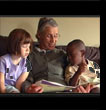
When Family and Identity Collide
Written by Kathleen McKenzie | Posted by: Anonymous
“I’ve been a Vermonter for 20 years,” said producer, director, and cinematographer Jeff Farber in a recent phone interview. NewEnglandFilm.com caught up with Farber as he prepared his latest film, Living on the Fault Line, for the Green Mountain Film Festival which takes place in Montpelier, Vermont, March 16-25, 2007.
Living on the Fault Line examines race relations between interracial adopted families, or transracial families, and Vermont’s predominantly white society. For the film, Farber interviewed seven transracial families during the summer of 2006. “Ultimately I wanted the stories in a cross-section,” said Farber. “I didn’t want to victimize any families by focusing on just one or two. I wanted a mosaic of families that were central to one issue like the film I did [in 2005] on autism, Living the Autism Maze.”
Farber has been an award-winning independent filmmaker for more than 25 years. He grew up in the Philadelphia area on Hollywood-produced films. After completing his undergraduate degree at Drexel University, he went on to pursue a master’s in film at Ohio University. “Unlike New York University and Los Angeles, Ohio had a small department which catered to independent filmmakers,” he said. Farber said he has always been drawn to documentaries, influenced by early pioneers of cinema documentary like Frederick Wiseman and the Maysles brothers (Albert and David). “I always had an interest in making social commentaries,” Farber said.
Before moving to Vermont in 1986, Farber, who is white, was a member of a multiracial film collective in Philadelphia, New Liberty Productions. The collective produced a film that strongly influenced him. “[Black & Blue] looked at police violence and the colonial nature of police in communities of color,” said Farber. “So I was very sensitive to both the overt and covert nature of racism in this country and the difficulties people of color have when interfacing with a predominately white community.”
According to Farber, Vermont’s population is 96 percent white. He especially wanted to explore the dynamics between white parents who adopted children of color, believing that the children would inevitably uncover racism held intimately by Americans. Farber said, “I’m using Vermont to examine how white America views people of color. The parents are seeing race through their children’s eyes.” He added that anecdotally, people from Vermont seem to think that because there’s more diversity in their social groups, that there’s less racism, “which isn’t necessarily true,” he explained.
Farber persisted in making the film despite several obstacles, such as identifying the right combination of families. This process took time. “We weren’t TV news,” he said. “We had to develop relationships with families.” He said that funding was also an issue but shooting in Vermont made the project more cost-effective. Farber worked with a crew from four to five people. “I directed and shot film,” he said. “There was an interviewer, a sound guy, and a grip.”
Farber said he will market his film to adoption agencies in order to educate potential parents about issues transracially adopted children face and also to trigger discussions that examine white privilege and institutional racism.
Recurrent throughout Farber’s film is an intentional message: The children of transracial families may not have the necessary background to cope in a society that judges largely by skin color and not family background. Farber said, “You may have friends of color but you may not have an idea what racism is.”
These issues are important to him because of firsthand experience. In 1990, his landlord and next door neighbor adopted an African-American child from Texas. “While this couple was very progressive and loving, I wondered if they truly understood the full dimensions of what it meant for their daughter who was to grow up in the whitest state in the union,” he said. “In 2004, I finally had the space in my life to begin developing the idea which is finally taking shape.”
Kathleen McKenzie lives in Boston and fills her spare time writing science fiction.
Living on the Fault Line screens at 6:30 pm on Friday, March 23rd and at 12 pm on Saturday March 24th. Albert Maysles, documentary legend and one of Jeff Farber's inspirations, will attend the festival as a special guest. Four of his films will screen as a tribute and Maysles will introduce and discuss his work. For a complete schedule visit www.GreenMountainFilmFestival.org. Kathleen McKenzie lives in Boston and fills her spare time writing science fiction.










